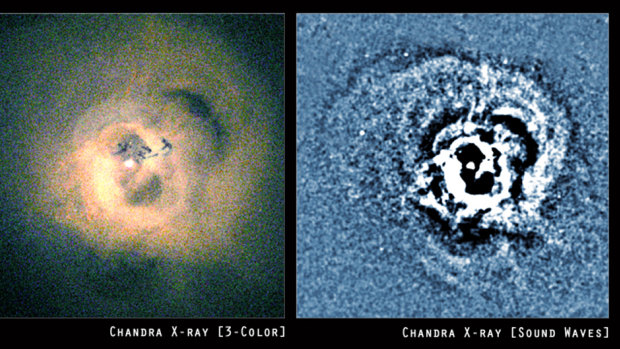What does a black hole sound like? Both “creepy” and “ethereally beautiful”, according to people who have listened to an audio clip posted on Twitter by NASA.
The US space agency tweeted what it called a remixed sonification of the black hole at the centre of a galaxy cluster known as Perseus, which lies about 240 million light-years away from Earth. The sound waves identified there nearly two decades ago were “extracted and made audible” for the first time this year, according to NASA.
The 34-second clip set social media ablaze, with many people gobsmacked that anything, let alone what sounds like an eerie, guttural moan, could escape a black hole.
But the idea that there is no sound in space is actually a “popular misconception,” the agency said. While most of space is a vacuum, with no medium for sound waves to travel through, a galaxy cluster “has copious amounts of gas that envelop the hundreds or even thousands of galaxies within it, providing a medium for the sound waves to travel,” it explained.
The clip, which NASA described as a “Black Hole Remix”, was first released in early May to coincide with NASA’s Black Hole Week – but a tweet on Sunday by the NASA exoplanets team really took off, with the clip being viewed more than 13 million times.
The sound waves were discovered in 2003, when, after 53 hours of observation, researchers with NASA’s Chandra X-Ray Observatory “discovered that pressure waves sent out by the black hole caused ripples in the cluster’s hot gas that could be translated into a note”.
The sound is emanating from the Perseus Cluster, a giant clump of galaxies some 250 million light-years from Earth.Credit:NASA/CXC/loA/A.Fabian
But humans couldn’t hear that note because its frequency was too low – the equivalent to a B-flat, some 57 octaves below the middle C note of a piano, according to NASA. So astronomers at Chandra remixed the sound and increased its frequency by 57 and 58 octaves. “Another way to put this is that they are being heard 144 quadrillion and 288 quadrillion times higher than their original frequency,” NASA said.
Kimberly Arcand, the principal investigator of the sonification project, said that when she first heard the sound in late 2021 – which she described as “a beautiful Hans Zimmer score with the moody level set at really high” –she jumped up in excitement.
“It was such a wonderful representation of what existed in my mind,” the visualisation scientist and emerging technology lead at Chandra said. But it was also a “tipping point” for the sonification program as a whole in that it “really sparked people’s imagination”, she said.
It also points to future areas of research. “The idea that there are these supermassive black holes sprinkled throughout the universe that are … belching out incredible songs is a very tantalising thing,” Arcand added.
Experts have cautioned that the sound in NASA’s remix isn’t exactly what you’d hear if you were somehow standing beside a black hole. Human ears wouldn’t “be sensitive enough to be able to pick up those sound waves,” Michael Smith, professor of astronomy at the University of Kent in England, said. “But they are there, they’re the right sort of frequency, and if we amplified it … we would then be able to hear it,” Smith said. He likened it to a radio – “you turn up the sound, the volume is higher, then you can hear it.”
Arcand said the idea took shape during the coronavirus pandemic. She had been working on turning X-ray light captured by Chandra’s orbiting telescope into images, including creating 3D models that could be printed to help people with low or no vision access that data. When the pandemic hit, that program became difficult to maintain remotely.
So, with other colleagues, she decided to try something new: sonification, or the process of translating astronomical data into sound. The team included experts who are blind and inspired Arcand “to think differently” about the value of translating complex data sets into sound.
Looking at the 2003 data on the Perseus galaxy cluster, she and colleagues worked to determine the properties of the pressure waves and deduce the sound they would produce, and then upped their frequency.
The decision to release the “re-sonification” of the nearly two-decades-old data is part of the agency’s efforts to use social media to communicate complex scientific discoveries in plain English to its millions of followers.
Through a partnership with Twitter, NASA discovered that “while its fans enjoyed stunning photos of space and behind-the-scenes looks into missions, there was a group of people who wanted to know what space sounded like, too,” the company wrote in a news release.
Some experts said the clip was confusing because it gave the impression that the sound “was somehow what you would hear if you were there”, Chris Lintott, a professor of astrophysics at the University of Oxford, wrote Tuesday on Twitter – as if you had a recording device directly translating the sound from the galaxy cluster to Earth.
“Sonification of data is fun, and can be useful – especially for those who may not be able to see images. But it’s sometimes used to make things seem more ‘profound’ than they are, like here,” Lintott added.
But Smith, the University of Kent professor, said “it’s perfectly sensible to say that there are sound waves [in the galaxy cluster], and if we were there, we could hear them if we had sensitive enough ears.”
Still, he acknowledged, “these galaxy clusters are so far away, they have to make a lot of assumptions to turn it into what we might hear if we were there.”
Arcand said she understood the criticism from some corners that sonification risks oversimplifying a complex process – particularly because the mix of pressure, heat and gas enabling the sound waves within the Perseus galaxy cluster is specific to that environment. But the value of sonification, she said, is that it made her “question things in different ways”.
“It’s a superb representation of the science, in my opinion, and a rather haunting sound!” Carole Mundell, head of astrophysics at the University of Bath in England, said via email.
The project, and NASA’s tweets about it, appear to have accomplished the space agency’s mission of sharing its science and research with the wider public in a conversational way – though not everyone was a fan of the remixed sounds of the black hole.
Online, people appeared both thrilled and terrified by it, making colourful comparisons to films from Lord of the Rings to Silent Hill.
Others had fun with the audio clip, overlaying an image of an intergalactic puppy onto it or remixing it with a re-created sound thought to be closest to the voice of a mummy.
“I can confirm that the black hole noise Nasa released is the sound of hell,” one dark-humoured Twitter user wrote. Another said: “New genre just dropped: Cosmic Horror.”
The Washington Post
Liam Mannix’s Examine newsletter explains and analyses science with a rigorous focus on the evidence. Sign up to get it each week.
Most Viewed in World
From our partners
Source: Read Full Article



